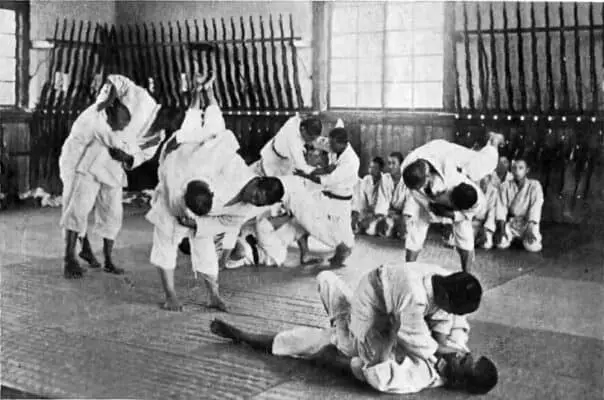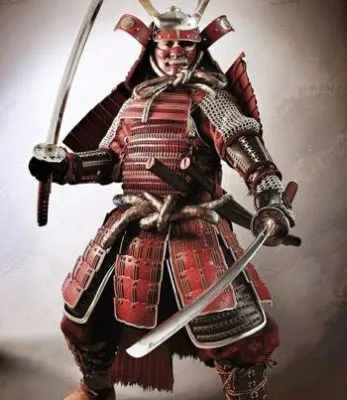
Japanese Jujutsu also known as Japanese Jiu-Jitsu (JJJ) is one of many martial arts to choose from if you want to learn how to fight. However, distinguishing between the martial arts can be challenging, particularly when there are others with similar names, such as Brazilian Jiu-Jitsu (BJJ). This article will help you understand the unique attributes of JJJ so that you know exactly what to expect as a student.
Japanese Jujutsu is an ancient martial art from which others, such as Judo and BJJ, were derived. It involves immobilization, throwing, striking, defense and sometimes the use of small weapons. Students also study technique theory, Japanese history and terminology, the human body and first aid.
There are more intricate details about JJJ below that will help you understand how it differs to other martial arts. There are also key differences between BJJ and JJJ that may lead you to believe that one is better than the other.
Brief History of Japanese Jujutsu
Japanese Jujutsu (JJJ) is an ancient martial art used in warfare, which stems from sumo and other Japanese martial art techniques. These techniques originate from the Nara period, but one of the oldest known styles of JJJ is Shinden Fudo, which was established in 1130AD.
The term ‘Jūjutsu’ means ‘gentle art’. This is because the techniques require very little of your own strength and use your opponent’s strength against them. ‘Jujutsu’, ‘Ju-Jitsu’ and ‘Jiu-Jitsu’ are all different spelling variations of the same techniques. The variations only came about due to the Western pronunciation of the word.
There have been many styles of Japanese Jujutsu taught over the centuries, but the techniques flourished just prior to the peaceful Edo period. In this time, warfare was reduced and hand-to-hand combat was the preferred fighting method, with weapons used more for decoration.
Although JJJ has been around for hundreds of years, the Japanese did not start using the term ‘Jujutsu’ until the 17th century, where it was used to encompass a variety of grappling styles. Even today there are many different JJJ schools, known as ‘Ryu’ that have their own unique styles and techniques.
There are a number of martial arts that were adapted from JJJ techniques. Some of these include Judo, Brazilian Jiu-Jitsu, Aikido and Sambo.
RECOMMENDED FOR YOU: What is Gracie Jiu-Jitsu? Fully Explained
Did Samurai Use Jiu Jitsu?
Samurai warriors used Jujutsu as one of their fighting styles to combat armed opponents with heavy battle armor. The Japanese Samurai were the noble warriors of Japan from the 12th century until their abolishment in 1876. They were some of the first warriors to use Jujutsu as a technique in warfare.

They recognized that, in the event that they were unarmed, striking was completely ineffective against an enemy. Introducing grappling, joint locks, throws and chokes to their fighting style allowed them to overcome their opponent by using their own force against them.
What Does Japanese Jujutsu Teach?
A Japanese Jujutsu syllabus is taught to students over a number of years as they progress through each ‘Kyu’ and ‘Dan’, which is the belt system used in JJJ. Students learn a combination of fighting techniques and theory throughout their journey to prepare both their body and their mind for defending themselves and others.
Fighting Techniques
Japanese Jujutsu teaches a broad range of fighting techniques, including offense and defense. Every school syllabus is different in exactly what techniques are taught, but most include the following.
Immobilization
- Ground grappling (Gatame Waza)
- Joint-locking (Kansetsu Waza)
- Strangulation (Shime Waza)
- Pinning (Osae Waza)
Throwing
- Throwing techniques (Nage Waza)
- Break-falling techniques (Ukemi Waza)
Striking and Defense
- Striking techniques (Atemi Waza)
- Blocking and parrying
- Postures and guard techniques
These are broad terms used to summarise hundreds of techniques that can be taught in JJJ. Some schools will include the use of weapons in their striking syllabus, such as Kenjutsu Kata (‘way of the sword’) and Jo-jutsu Kata (‘way of the wooden staff). On the other hand, some schools will only teach unarmed techniques.
Theoretical Knowledge
Japanese Jujutsu also encompasses a wide range of theory so that students have a well-equipped mind for a fight. Black belts may even be required to produce written papers proving the depth of their knowledge of Jujutsu theory. Students usually will learn aspects of the following as they progress through their training.
- Japanese history
- Japanese terminology
- Theory behind each fighting technique
- Anatomy and physiology
- First aid and other ‘healing arts’
Is Japanese Jujutsu Effective in a Street Fight?
Japanese Jujutsu techniques are effective in a street fight. They provide the skills necessary to strike your opponent or defend yourself, as well as provide first aid if needed.
However, many JJJ techniques can seriously harm your attacker. Ideally, you should be able to defend yourself and control your attacker without anyone getting hurt. Unfortunately, if your attacker falls to the ground and hits their head after a strike or throw, the head injury could be fatal. Death is never the best outcome, regardless of whether they tried to hurt you.
RECOMMENDED FOR YOU: What Is Combat Jiu-Jitsu? An Introduction To Combat Jiu-Jitsu
What is the Major Difference between BJJ and JJJ?
Although BJJ was derived from Japanese Jujutsu(JJJ), there are still a number of key differences that separate the two martial arts. These are listed below.
Purpose
JJJ was originally intended for war, meaning that many techniques were designed to seriously injure or even kill your opponent. BJJ, on the other hand, was tailored as a means of self-defense. The primary purpose is to defend against an attacker without causing them any serious harm.
Techniques
As mentioned above, there are hundreds of techniques within JJJ, grouped into broad categories. There are also over 600 recognized techniques in BJJ. However, BJJ does not include striking or throwing techniques of any kind.
All offensive techniques in BJJ can be categorized into choke-holds or joint-locking. Instead of throwing opponents to the ground, BJJ practitioners will ‘sweep’ their legs. This ties in with the primary purpose to prevent serious harm to your attacker in BJJ.
Belt System and Grading
Many JJJ schools have adopted the colored belt system designed by Jigoro Kano, the creator of Judo. Belts are divided into ‘Kyu’ for colored belts and ‘Dan’ for black belts. There are 10 Kyu to progress through before reaching Dan. However, some JJJ schools do not use the belt system at all.
In order to be promoted to the next belt, a JJJ student must be formally assessed by performing a number of techniques in front of an assessor. In addition to this, they must demonstrate the theoretical knowledge required for that belt.
In BJJ, belts are named according to their color, such as ‘blue belt’. There are only four colored belts before black belt, but each have four ‘stripes’ to progress through. In addition to this, students receive promotions when their instructor thinks they are ready, simply through observation during lessons.
Competitions
JJJ is more of a way of life than a sport, teaching students discipline, respect and theoretical knowledge. Sport Jiu-Jitsu competitions are the only means of competing as a JJJ practitioner, but the rules prohibit a number of JJJ techniques, such as kicks to the legs or strikes to the face.
BJJ, on the other hand, is very competition-focussed. There are several BJJ competitions, such as the IBJJF World Championship and Abu Dhabi World Pro, which practitioners can take part in. BJJ practitioners can use almost all BJJ techniques in these competitions because they will not cause serious harm to the opponent (if controlled and used correctly).
RECOMMENDED FOR YOU: BJJ vs Japanese Jiu-Jitsu – Key Differences and Similarities further explains everthing you need to know about the difference between BJJ vs Japanse Jiu-jitsu.
Which Is Better BJJ or Japanese Jujutsu?
BJJ and JJJ both have their strengths and weaknesses. Overall, BJJ is more practical, teaching students techniques that will help control an attacker. Although it does not specifically train defense against weapons, it focuses on knowing how to avoid a fight and when to engage in a fight safely.
Japanese Jujutsu is still useful for fighting, but includes a much broader curriculum. This means you may find JJJ better than BJJ if you are interested in learning about Japanese culture, the history of JJJ, how the human body works and how to treat injuries. JJJ also offers striking techniques, so people who would like to learn offense as well as defense may prefer JJJ.
Are Weapons Used in Japanese Jujutsu?
Japanese Jujutsu is mostly hand-to-hand combat, which is why it flourished when carrying a weapon became illegal in 17th-century Japan. However, it was not a completely weapon-free martial art, including those listed below.
- Knives
- Wooden staff
- Short swords
- Ropes
Many modern JJJ schools do not include the use of weapons in their curriculum, but will still teach defense against weapons. Schools will tailor their weapon defense training to common street weapons, such as bats, pocket knives and guns. However, you can still find some schools that will train their students how to use these smaller weapons.
Is Japanese Jujutsu Still Practiced Today?
Japanese Jujutsu is still practiced internationally today across hundreds of schools, known as ‘Ryu’. Many senior instructors have studied in Japan or under a Japanese master. However, each school adheres to one particular style of Japanese Jujutsu, such as Takenouchi-Ryu, which is one of the oldest forms of Japanese Jujutsu.
In addition to this, JJJ has also become more widespread through the use of the internet and online instructional videos. Many instructors will record certain techniques and upload them for others to learn. This has allowed JJJ to reach those that may not have a local school available.
In terms of using JJJ in a practical setting, most practitioners prefer to think of JJJ as a way of life. Although it provides a means of self-defense when the situation arises, it also teaches discipline and respect that can be used in everyday life.
